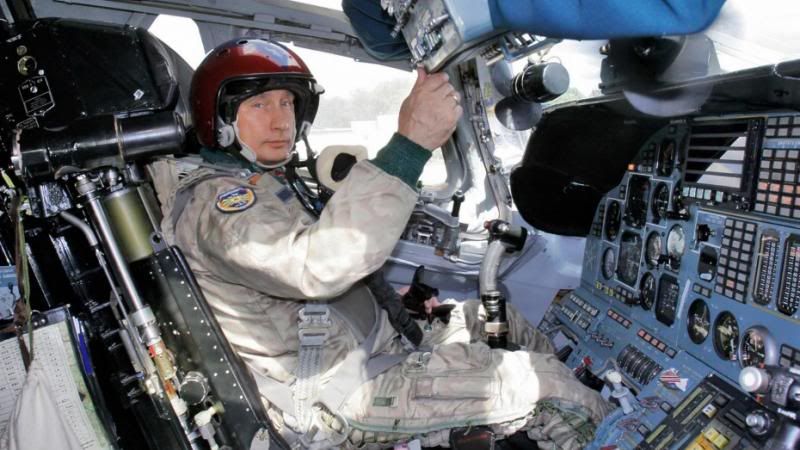http://www.nationaljournal.com/global-security-newswire/could-the-u-s-face-a-cruise-missile-threat-from-the-gulf-of-mexico-20140321
Russian President Vladimir Putin poses inside a cruise missile-equipped Tu-160 strategic bomber in 2005. The United States is working "very hard" to bolster its defenses against potential cruise-missile threats from the Gulf of Mexico, a senior military official said last week.(Vladimir Rodionov/AFP/Getty Images)
By Diane Barnes
March 21, 2014
The United States is puzzling over how to block cruise missiles that theoretically could be launched from the Gulf of Mexico, even after throwing some of its most advanced technologies at the problem.
Russia and Iran have been cited as possible threats that might, at some point, lurk in the waters just off U.S. shores.
A 2013 military exercise pitted systems such as Patriot interceptors, Aegis warships and combat aircraft against potential cruise-missile or short-range ballistic missiles fired from the Gulf. But the drill highlighted a particular vulnerability to cruise missiles lobbed from that region, U.S. Northern Command head Gen. Charles Jacoby indicated in congressional testimony last week.
He said the Pentagon has "some significant challenges" in countering these missiles, but is exploring "some opportunities to use existing systems more effectively to do that." Many detailed results of the Oct. 11 drill conducted near Key West, Fla., remain classified, Jacoby said.
"The cruise-missile threat portion of that we are working on very hard," the general added at the March 13 Senate Armed Service Committee hearing, in response to a question from Senator Ted Cruz (R-Texas).
The military leader -- whose command focuses on defense of the U.S. homeland -- referenced an initiative to quickly mobilize assets against such threats in a configuration called the Joint Deployable Integrated Air and Missile Defense system.
The effort is housed within the Pentagon's Joint Test and Evaluation program, which aims to address "operational deficiencies" in military preparedness, according to information released by the Pentagon.
"The idea is to cobble together enough stuff [so] that maybe something will work. But none of these systems were designed for cruise-missile defense," Kingston Reif, an analyst with the Center for Arms Control and Nonproliferation, said in an e-mail.
Cruise missiles can be particularly challenging to defend against, as they can be more difficult than aircraft to detect on radar and are sometimes tricky to shoot down, according to military experts.
A 2013 U.S. military intelligence report forecasted that cruise missiles would spread into more hands over the coming decade. The document also hints at the ability to evade defenses designed against ballistic missiles.
"Cruise missiles can fly at low altitudes to stay below enemy radar and, in some cases, hide behind terrain features. Newer missiles are incorporating stealth features to make them even less visible to radars and infrared detectors," says the 2013 assessment by the National Air and Space Intelligence Center.
Cruz's office did not respond to requests to discuss his specific concerns about potential attack risks facing the United States from the Gulf of Mexico. His comments came, though, in the wake of some other public discussion of possible threats of this kind.
Iran last month announced it intended to deploy warships near the U.S. maritime border, prompting heightened discussion of the Middle Eastern nation's growing military capabilities.
At last week's hearing, Jacoby also spoke to Moscow's cruise-missile capabilities.
Responding to a question from Senator Jeff Sessions (R-Ala.), the Northern Command leader said the United States has been "tracking for a number of years Russia's continued investment in improved cruise missile technology."
The Kremlin has armed its bomber aircraft with cruise missiles for decades, he noted.
"They also are capable of introducing cruise missiles into a theater from submarines," said Jacoby, without elaborating on the specific regions to which these vessels could deploy. "They've just begun production of a new class of quiet nuclear submarines specifically designed to deliver cruise missiles."
One 2012 news article quotes U.S. government insiders asserting that a Russian submarine equipped with cruise missiles had evaded detection for weeks in the Gulf of Mexico. However, the Defense Department denied the contentions described in the Washington Free Beacon report.
The fiscal 2014 defense authorization bill, enacted in December, mandates a U.S. defense focus on "ballistic missiles that could be launched from vessels on the seas around the United States, including the Gulf of Mexico."
Jacoby said the increased focus on cruise-missile defense took shape well over a year ago, at the direction of then-Defense Secretary Leon Panetta.